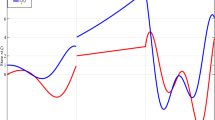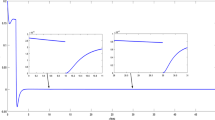Abstract
Up to now, the research topic about fractional-order complex networks is mainly focused on the synchronization. In this paper, synchronization for a class of fractional-order linear complex networks is realized via impulsive control. The general expression of solution for a fractional-order impulsive error system is deduced by utilizing iteration algorithm. Some inequality conditions are established to guarantee that the largest Lyapunov exponents of each node are negative, which means that the corresponding error system is asymptotic stable and synchronization is realized. It is the first time to achieve the synchronization of fractional-order systems based on the largest Lyapunov exponent. Finally, examples are present to illustrate the validity and effectiveness of proposed conclusions. Numerical simulations also indicate that the fractional-order parameter has a great influence on the largest Lyapunov exponent, although it is not reflected in the theoretical analysis.
Similar content being viewed by others

References
K. B. Shi, X. Z. Liu, H. Zhu, S. M. Zhong, Y. Zeng, and C. Yin, “Novel delay-dependent master-slave synchronization criteria of chaotic Lur’e systems with time-varying-delay feedback control,” Applied Mathematics and Computation, vol. 282, pp. 137–154, 2016.
Q. Wang and D.-L. Qi, “Synchronization for fractional order chaotic systems with uncertain parameters,” Control Theory and Applications, vol. 14, no. 1, pp. 211–216, February 2016.
K. B. Shi, Y. Y. Tang, X. Z. Liu, and S. M. Zhong, “Nonfragile sampled-data robust synchronization of uncertain delayed chaotic Lurie systems with randomly occurring controller gain fluctuation,” ISA Transactions, vol. 66, pp. 185–199, January 2017.
S. Song, X.-N. Song, N. Pathak, and I. T. Balsera, “Multiswitching adaptive synchronization of two fractional-order chaotic systems with different structure and different order,” Control Theory and Applications, vol. 15, no. 4, pp. 1524–1535, August 2017.
K. Z. Guan, “Global power-rate synchronization of chaotic neural networks with proportional delay via impulsive control,” Neurocomputing, vol. 283, pp. 256–265, March 2018.
Y. Tang, F. Qian, H. J. Gao, and J. Kurths, “Synchronization in complex networks and its application-A survey of recent advances and challenges,” Annual Reviews in Control, vol. 38, no. 2, pp. 184–198, September 2014.
X.Wu, D. Lai, and H. Lu, “Generalized synchronization of the fractional-order Chaos in weighted complex dynamical networks with nonidentical nodes,” Nonlinear Dynamics, vol. 69, no. 1–2, pp. 667–683, December 2012.
J. Yu, C. Hu, H. J. Jiang, and X. L. Fan, “Projective synchronization for fractional neural networks,” Neural Network, vol. 49, pp. 87–95, January 2014.
J. Wang and C. Zeng, “Synchronization of fractional-order linear complex networks,” ISA Transactions, vol. 55, no. 1, pp. 129–134, March 2015.
S. Liang, R. Wu, and L. Chen, “Adaptive pinning synchronization in fractional-order uncertain complex dynamical networks with delay,” Physica A: Statistical Mechanics and its Applications, vol. 44, pp. 49–62, February 2016.
J. W. Wang and Y. B. Zhang, “Network synchronization in a population of star-coupled fractional nonlinear oscillators,” Physics Letters A, vol. 374, no. 13–14, pp. 1464–1468, March 2010.
Y. Tang and J. A. Fang, “Reply to the comment on “Synchronization of N-coupled fractional-order chaotic systems with ring connection”,” Communications in Nonlinear Science and Numerical Simulation, vol. 15, no. 12, pp. 4244–4245, December 2010.
S. S. Delshad, M. M. Asheghan, and M. H. Behesh, “Synchronization of N-coupled incommensurate fractionalorder chaotic systems with ring connection,” Communications in Nonlinear Science and Numerical Simulation, vol. 16, no. 9, pp. 3815–3824, September 2011.
T. D. Ma, J. Zhang, Y. C. Zhou, and H. Y. Wang, “Adaptive hybrid projective synchronization of two coupled fractional-order complex networks with different sizes,” Neurocomputing, vol. 164, no. C, pp. 182–189, September 2015.
R. Rakkiyappan, J. G. Cao, and G. Velmurugan, “Existence and uniform stability analysis of fractional-order complexvalued neural networks with time delays,” IEEE Transactions on Neural Networks and Learning Systems, vol. 26, no. 1, pp. 84–97, March 2014.
T. D. Ma and J. Zhang, “Hybrid synchronization of coupled fractional-order complex networks,” Neurocomputing, vol. 157, pp. 166–172, June 2015.
Q. X. Fang and J. G. Peng, “Synchronization of fractionalorder linear complex networks with directed coupling topology,” Physica A: Statistical Mechanics and its Applications, vol. 490, pp. 542–553, September 2018.
Y. Yang, Y. He, Y. Wang, and M. Wu, “Stability analysis of fractional-order neural networks: An LMI approach,” Neurocomputing, vol. 285, pp. 582–93, April 2018.
Author information
Authors and Affiliations
Corresponding author
Additional information
Recommended by Associate Editor Ho Jae Lee under the direction of Editor PooGyeon Park. This work is supported by National Natural Science Foundation of China under Grant 61775198 and 61603348. The work is also sponsored by Natural Science Foundation of Henan Province under Grant 162300410323, 182102210160 and Doctor Scientific Research Fund of Zhengzhou University of Light Industry under Grant No. 2014BSJJ047.
Na Liu received her Ph.D. degree in Control Theory and Control Engineering from Huazhong University of Science and Technology in 2010. Her research interests include nonlinear control, chaos, and complex networks.
Jie Fang received her Ph.D. degree in Control Theory and Control Engineering from Nanjing University of Aeronautics and Astronautics in 2012. Her research interests include nonlinear control, chaos, and complex networks.
Wei Deng received her M.S. degree in Electrician Theory and New Technology from Zhengzhou University in 2007. Her research interests include nonlinear control, chaotic synchronization and control.
Zhen-Jun Wu received his Ph.D. degree in Power Electronics and Power Transmission from Chinese academy of sciences in 2009. His research interests include nonlinear control, power quality and electromagnetic compatibility.
Guo-Qiang Ding received his Ph.D. degree in Navigation, Guidance and Control, from Harbin Engineering University in 2010. His research interests include navigation automation technology, nonlinear optimal filtering theory and algorithm, computer integrated measurement.
Rights and permissions
About this article
Cite this article
Liu, N., Fang, J., Deng, W. et al. Synchronization for a Class of Fractional-order Linear Complex Networks via Impulsive Control. Int. J. Control Autom. Syst. 16, 2839–2844 (2018). https://doi.org/10.1007/s12555-017-0403-9
Received:
Revised:
Accepted:
Published:
Issue Date:
DOI: https://doi.org/10.1007/s12555-017-0403-9



